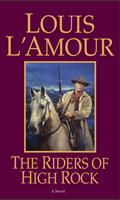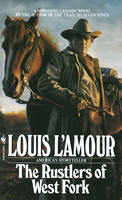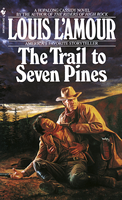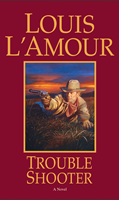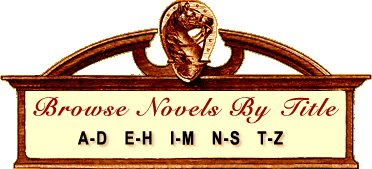
Click A-D above to begin browsing
novels by title.
THE HOPALONG CASSIDY NOVELS
CLICK HERE for a special deal!
CLICK HERE to view the
Hopalong Cassidy Audio Books
About the Hopalong Cassidy Novels by Louis L'Amour
My father was Tex Burns. He's gone now, so I feel it's time to stop denying it. I really don't think that Tex ever did anything he needed to be ashamed of; all he did was lose an argument. Nonetheless, Tex Burns was persona non grata around our house.
In the spring and summer of 1950, Louis L'Amour wrote four stories about Hopalong Cassidy. He used the pen name Tex Burns and the books were commissioned by Doubleday's Double D Western imprint. The Rustlers of West Fork, Trail to Seven Pines, Riders of High Rock and Trouble Shooter were the first four novels that he had ever published.
But for the next thirty-eight years he denied that he had ever written any of them.
When asked, he told people that he had never written about Hopalong Cassidy, that he had never written as Tex Burns. At autograph sessions he would refuse to sign the Hopalong books that fans would occasionally bring. And for years he worried that these books which he tried so hard to ignore would be reprinted and brought back into circulation.
I first heard about the situation when I was ten or eleven. Dad had just returned from doing a radio call-in show and as we sat down to dinner he grumbled something about how he wished people would stop asking about Hopalong Cassidy.
I asked him what the matter was, and he gave Mom a look (the kind parents give each other when their children up and say something that makes people uncomfortable). He put down his fork. "A long time ago," he said, "I wrote some books, I just did it for the money, and my name didn't go on them. So now, when people ask me if they were mine, I say no."
"But you did write them, didn't you?" I asked. This sounded vaguely like a secret . . . very important to a kid.
"Yes," he sighed.
"And when people ask you if you wrote them, you tell them you didn't? Isn't that lying?"
"I just wrote them for hire. They weren't my books." a non-answer.
I had hit a nerve that youngsters seem to have a magical talent for finding. The Parent Paradox. To be a "good parent," Dad has to tell junior not to lie, that lying is bad. Of course, everybody lies. The real issue is how often, and to what extent do you distort the truth - a subject too complicated for many kids . . . and some adults.
"But why don't you tell them the truth?" I asked. As a kid, you always suspect that adults have a whole other set of rules made up for themselves. Like all children, I found a lot to lie about. When adults would ask "Who broke this?" the last thing that came to mind was what really happened. But I understood that kind of lying, there's a motive to it.
"Beau," he said, "I don't care for the books, and I don't care for the whole situation. Those books have no relationship to the work I'm doing now. They agreed I could write them one way but then they went back on their deal."
"But you still wrote them," I protested.
Dad said something designed to shut me up and we went on with dinner.
Now, years later, I understand his problem all too well. He had, at some point, begun telling people that the four Hopalong Cassidy stories he wrote were not his. After that, he had to lie to keep his story straight . . . so people wouldn't catch him lying. And when you're a dad, I guess that's the last thing you want your son to catch you doing. It's what you're trying to protect him from.
In the following years the character of Hopalong Cassidy faded away into the past and Louis L'Amour became more and more famous. L'Amour paperbacks sold in the millions of copies while the novels about Clarence Mulford's cowboy-hero disappeared from the shelves. The triple-feature theaters, where the black-suited Bill Boyd used to appear, were turned into strip malls. And finally, after pioneering the airwaves and a decade of reruns, Hoppy vanished from television. L'Amour fans, however, still occasionally asked "THAT" question.
They had good reason to ask, because there was evidence. Somehow the copyright form to one of the stories reads "Author: Louis L'Amour," rather than "Tex Burns." The United States Government knew who had written those books and the information was there for anyone to check. Trouble was, Dad still denied it.
He kept on denying it until he died. When Bantam's parent company acquired Doubleday, the publishing house that owned the books, he was relieved. Now Bantam could forever block the sale of the hated books. As I got older I learned that I was never going to get a complete answer out of him, and so I stopped asking.
After his death we discovered some of his correspondence with the editors of the Hopalong Cassidy magazine. I read The Rustlers of West Fork and Trouble Shooter (the first and last of his Cassidy novels), and began to put together my own version of why he couldn't admit that he wrote the books.
The story goes like this . . .
Sometime between 1906 and 1908 (coincidentally the year my father was born), Clarence E. Mulford wrote a series of magazine stories that were collected into a novel titled BAR 20. It chronicled the adventures of Buck Peters, foreman of the Texas ranch, and others, including a rough-talking red-haired cowpuncher named Bill Cassidy. He got the nickname Hopalong after he was wounded in the thigh by a bullet. Peters eventually left to run his own ranch in Montana and Hoppy became the foreman of the Bar 20.
Over the course of his career (roughly 1906 - 1941) Mulford wrote more than two dozen novels, the majority of which were about Hopalong Cassidy and the other characters from the Bar 20 ranch. In 1941 he published the last of his Cassidy novels, Hopalong Cassidy serves a Writ, and retired on the money made by his extraordinarily popular books and the sale of their film rights.
In 1935 producer Harry Sherman had hired William L. Boyd to appear as Hopalong Cassidy in what would be the first of 118 films (including TV episodes) about the Cassidy character. From the first, Boyd showed a great deal of concern and control over the image of Hopalong. Allegedly he insisted on the black costume, white horse, and nickel-plated guns that became his trademark in the films. The story is that he also consulted with the writers on cleaning up the foul-mouthed, hard-drinking, but basically realistic character from the Mulford books. The Hoppy of film and television was a well-laundered gentleman who abstained from tobacco, alcohol and profanity. He was a character who (though perhaps not a first) became more and more aimed at an audience of children. It is reported that Mulford was disappointed in the movies. "The only comment I have to make," he said laconically, "is that he is not properly dressed for the part."
Some thirty Hopalong Cassidy movies had been made between 1941 (when Clarence Mulford retired) and 1950. It seems that Doubleday began to feel that some new Hopalong Cassidy books could do well in a market that supported so many movies. They put together an agreement with Better Publications to release the stories in magazine form as well and asked Mr. Mulford to come out of retirement. For reasons of his own, he turned them down. He was however, willing to license them the rights to the character so that another writer could do some new stories . . . and for better or worse he chose my father to be that writer.
Dad had been writing for Thrilling magazines for about ten years. Before the war he wrote the very successful "Ponga Jim" Mayo series for Thrilling Adventures, while afterwards he built up a good career selling to the Thrilling Western and Thrilling Detective pulps. I assume that he, and probably several other writers, were recommended to Mulford by Leo Margulies, the editorial director of Better Publications.
Mulford chose my father. Now that I have read some of the original Cassidy stories, I am not in the least surprised, for they were soul mates. Although the sound and the flow of their writing was different, both wrote with boiling energy. When my father began a story he never looked back. He made it up as he went along, rarely planning what was going to happen. The stories of Clarence Mulford have the same feeling of spontaneity, the same sense that the writer was totally immersed in the world of his creation. Both seemed to be writing for their own entertainment as much as for that of the audience.
I know that my father was flattered at having been chosen. Mulford had made it big as a novelist, and that was a world that my father hoped to break into also. Although he never mentioned it to me, I'm also sure that Dad read several of the early Mulford books as he was growing up. I've tried to imagine being asked if I wanted to be the literary successor to Ross MacDonald or Ray Bradbury, and the idea sends chills up my spine. Of course I want to write my own stuff, and so did he, but as long as that wasn't happening they sure wouldn't have to beg me.
They didn't have to beg Dad, because along with being flattered, he was hungry. He was living in Los Angeles, subletting a room from a family who had an upper duplex in the Wilshire district. I know he was having a tough time because he made no journal entries that year at all (Dad was always better at writing in his journal when he was both motivated and productive).
Mr. Margulies sent him copies of the Hopalong Cassidy stories and Dad studied up. I know that he had several discussions with the executives of both the magazine and Doubleday regarding the characterization of Cassidy. They were entertaining the idea of patterning him after Bill Boyd because of the very successful movies, but Dad insisted on Mulford's original and more colorful interpretation. They were probably eager to get the first edition out in time to coincide with the NBC premier of the Hopalong Cassidy Show, which had been given a Sunday 6:00-7:00 P.M. time slot starting the 1st of October. They asked him to start immediately.
On January 4, 1950, Dad received this letter (which I've edited a bit).
Dear Louis,
I'm glad that you are interested in doing the Hopalong Cassidy Novels in our new magazine of that name. We are going to pattern the magazine novels after the Mulford books and will attempt to retain as much of the Mulford character as possible. You will notice in reading the very last of the Hopalong Cassidy novels that he was a deputy sheriff. However, in my opinion, we should steer clear of any form of lawman characterization, deputy marshal, or otherwise. I think we should have him a free lance trouble shooter, drifting along and settling range, town and other western problems. We don't want him to lose touch with his old pals like Mesquite Jenkins, Buck Peters, Jonny Nelson, etc. the should appear in the stories now and then, but the stories should not be tied in with the Bar 20 or any of the other ranches established by Hopalong's pardners.
There may be a slight woman interest in the stories, but it should be handled so that it is more of a case of hero worship - Cassidy rides off into the distance and the gal looks after him wistfully. I don't think Mulford used the limp for a good many years, especially in his later stories. I know that they don't have him limp in the movies, so lets forget the limp.
The reason we are buying ALL RIGHTS is because we are merely being licensed to use the Hopalong Cassidy novels for one time use in our magazine. Therefore it is necessary for us to do business with an author from whom we can purchase ALL RIGHTS for a flat fee. [Dad got $1,000 and his agent took 10%.] If you don't find that this arrangement meets with your approval, let me know immediately so that we can make contact with another writer who will be interested in doing these stories on the terms we can offer.
We plan to do the magazine on a quarterly basis. Maybe more than that if it catches on. The first one should be written as soon as possible, and if I were you I would plan a new one every other month or sixty days apart. Please let me know, and my best regards.
Sincerely yours,
Leo Margulies
As you can see, when Dad said that it was work for hire, he ment it.
Another detail, not mentioned in this letter here, was the issue of credit. Before the war, when Dad was writing adventure and sports stories, nobody had any objections to his using his own name. But in the mid '40's, when he started trying to sell Westerns, he ran into trouble. The management at Better Publications did not believe they could sell Western stories by a writer named Louis L'Amour. Westerns had to be written by a man who could have been a cowboy and everybody knew that cowboys had short, tough-sounding names: Luke Short, Max Brand, Will Henry, Brett Hart, Zane Grey. They told Dad that no one with a name like Louis L'Amour could ever sell Westerns - it was too hard to pronounce, too soft sounding, it was too, well . . . foreign. Irritated at having to use a pseudonym, he chose Jim Mayo, the name he had originally created for the hero of his South Seas adventure series. The "Ponga Jim" Mayo stories had been written under his own name, and so there was at least a slight connection.
When the issue of the Hopalong stories came along, the editors asked Dad to write under still another name: Tex Burns. I think another reason they did this was so that, if the publisher became dissatisfied with Dad, someone else could be hired to write as Tex Burnes without the readers' knowing there had been a change.
Louis wrote The Rustlers of West Fork and Trail to Seven Pines very quickly. By June of 1950 he was about to finish Riders of High Rock when he received some bad news from the offices of Better Publications in New York. Doubleday was getting around to preparing their hardcover edition of Rustlers and it's my guess that they wanted to capitalize on the other version of Hopalong Cassidy.
The movies had turned Hoppy into a merchandising phenomenon, and the upcoming national TV release was expected to send it through the roof. By January of '50 there was both a radio show starring - who else - Bill Boyd, and a comic book that represented Cassidy with a likeness of the silver-haired actor.
In an extraordinarily canny move, Boyd had previously sold almost everything he owned to raise the money to buy the rights to all the early Hopalong films and was now selling them to television. As if that weren't enough, he was in the process of preparing yet another fifty Cassidy episodes aimed directly at the small screen. He was also selling Hopalong Cassidy clothes, breakfast food, towels, watches, bicycles, and candy.
In light of all this it seems that the publisher wanted a Hoppy that the masses would recognize, not the rough-edged character that no one one had heard from in a decade. They wrote to my father and told him to change his stories to use a Hopalong in the Bill Boyd mode.
Now Dad hated rewriting, and he'd never liked to be told what to do. He had a lot of respect for Clarence Mulford and felt that he was doing his best to carry on in his tradition. Doubleday had been Mulford's publisher since 1925 and I think that Dad was deeply disturbed by the thought of being involved in selling out the writer to a company that ought to have had more respect for his work.
Unfortunately he was broke. Los Angeles, even in 1950, was an expensive place. The last third of 1949 he had spent writing Westward the Tide (a book that would not appear on the American market for twenty-seven years) and thus hadn't made his usual number of short-story sales. Dad's income for the year had been barely over three thousand dollars. Although more and more bothered by the entire situation, he went back and changed the manuscripts for Doubleday. Then he proceeded to write Trouble Shooter with the character that looked and acted like Bill Boyd. (An interesting note: Hopalong Cassidy's Western Magazine published the first two stories the way my father originally wrote them, but Riders of High Rock and Trouble Shooter used the revised description.)
In the following years Louis L'Amour went on to produce successful and respected work under his own name. And somewhere along the line a fan, or an editor, or a reporter, came up to him and asked if he was the guy who wrote those Hopalong Cassidy books back in 1950. At that point he had a decision to make, and not knowing that he would go on to become much more famous and thus closely scrutinized, he lied because he didn't feel good about what he'd done, and he didn't want to spend all night justifying his actions.
For the sake of consistency, he kept on doing it until he died.
Then one day, two years later, I pulled his old copy of Hopalong Cassidy, Trouble Shooter off the shelf and read it.
And it wasn't bad.
I liked it, and I am not uncritical of my father's work. I realized that, regardless of Dad's feelings about changing the description of the character, it didn't matter. He was obviously not trying to copy Mulford's (rather Victorian) style. The book was a good example of vintage L'Amour work, and one that I felt ought to be made public.
There. Now that that's over with, I have a few more things to say. First, about Clarence Mulford and my father: I found some interesting similarities between them as I was writing this afterword. Both men prided themselves on their research into the historical aspects of the West and both maintained enormous libraries to support their research habit. Each sold millions of copies and was extraordinarily successful for his day. Although he wrote westerns about other characters, Mulford's most popular books were about Hopalong and his friends. Dad's were the Sackett series. Lastly, both were exercise fanatics and eventually (late seventies for C.M., eighty for L.L.) died of lung disease. (I'm not sure but I think that Mulford's problem was also cancer.) Seeing that C.L. Mulford chose Louis L'Amour as his successor, it is interesting to note that the man who was perhaps the most widely read author of westerns in the first half of the twentieth century passed the torch to the man would was the most widely read author of westerns in the second half.
Besides Hopalong Cassidy, you will meet a few of Mulford's original characters from the Bar 20 stories in this book (The Rustlers of West Fork). Buck Peters, whose money Hopalong is delivering to Dick Jordan, was the original foreman o the Bar 20 ranch. Tex Ewalt (who is only mentioned in this book) and Johnny Nelson are also characters that date back to the novel Bar 20 (1907). Johnny goes on to become the hero of both The Man from Bar 20 (1918) and Johnny Nelson (1920). He also appears, in a more minor way, in several other stories. Mesquite Jenkins first appeared as a character in Hopalong Cassidy Returns (1925), and continued in Hopalong Cassidy's Protégé (1926). Mesquite also appeared without Hopalong in his own novel, Mesquite Jenkins (1928).
Even though I discovered that the magazine version of this and the next Hopalong novel used the description of Cassidy that Dad had written originally, I decided to leave these stories the way Doubleday printed them - that is, with a Bill Boyd-like Hoppy. The reason is consistency. The last two magazine stories use the cleaned-up Hopalong and that's the way that all four stories appeared in book form.
Looking back on all the trouble Dad went to to keep his association with the Hopalong books a secret, there is surprisingly little difference between his original version and the "revised" one. Nothing but the physical description of the character, the occasional mention of his smoking, and the inclusion of the movie Hoppy's horse, Topper, has been changed. These changes were plugged in with no alteration of the surrounding text. At times you can catch Dad trying to downplay the Bill Boyd image; he mentions that Hoppy's silver guns were "worn"' or that Cassidy wore clothes that were "no different" than other Western men might wear. The most glaring example of this is that Hoppy manages to abandon Topper at Sim Thatcher's ranch for almost the entire length of The Rustlers of West Fork.
It is my opinion that the reason for Louis' continued and emotional denial of the books came from irritation at himself for having started that process of denial to begin with, than his anger at being told to alter the character description.
BEAU L'AMOUR

Check out these other great values and gift sets!

